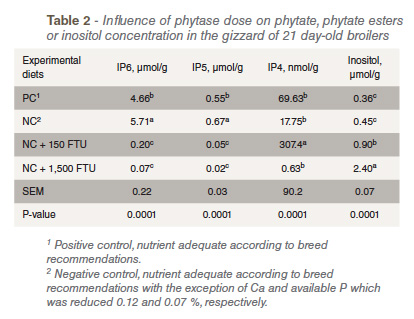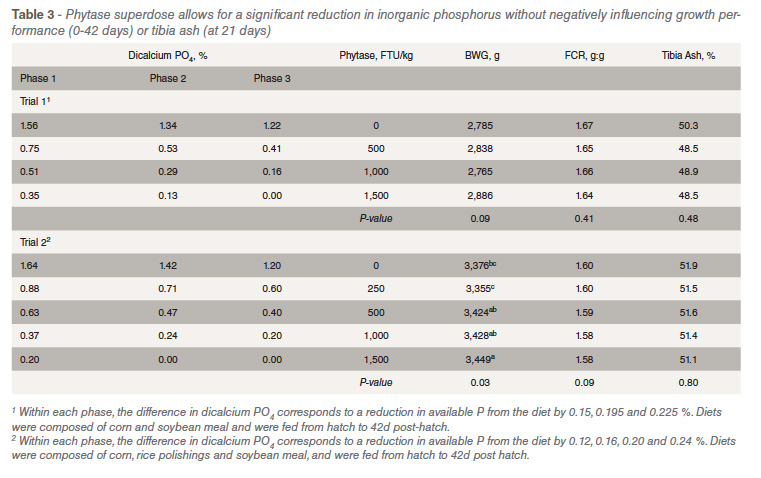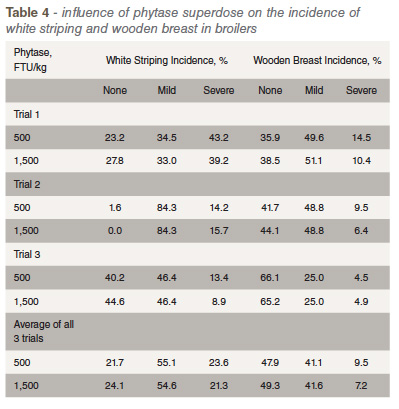
It is well documented that phytase supplementation in broiler diets improves P and Ca utilization through the destruction of phytate (IP6) and thereby allows for the reduction of inorganic phosphate in the diet.
Introduction
Phytase is supplemented in approximately 95% of the poultry diets globally with the majority of the use associated with reduced diet cost and reduced phosphorus (P) excretion. For the purpose of this paper, this type of phytase supplementation will be referred to as the standard dose of phytase, normally around 500 FTU/kg.
Superdosing is a relatively new term used to describe  phytase supplementation at ≥ 1,500 FTU/kg (Walk et al., 2014) or ≥ 2,500 FTU/kg (Adeola and Cowieson, 2011). This is predominantly associated with improvements in feed efficiency by 3-5 FCR points (Walk et al., 2013, 2014) through the rapid and nearly complete destruction of IP6 and the provision of inositol (Adeola and Cowieson, 2011; Walk et al., 2014).
phytase supplementation at ≥ 1,500 FTU/kg (Walk et al., 2014) or ≥ 2,500 FTU/kg (Adeola and Cowieson, 2011). This is predominantly associated with improvements in feed efficiency by 3-5 FCR points (Walk et al., 2013, 2014) through the rapid and nearly complete destruction of IP6 and the provision of inositol (Adeola and Cowieson, 2011; Walk et al., 2014).
Through near complete destruction of IP6, more P is released from the phytate molecule, and other nutrients such as iron (Fe), zinc (Zn), copper (Cu), and sodium (Na) become more available to the animal as well. Therefore, superdoses of phytase could have multiple uses towards achieving sustainable poultry production; this is associated with improvements in feed efficiency, mineral utilization, and poultry products, with specific consideration regarding fast growth, minerals and breast meat myopathies.
Superdoses of phytase
Feed efficiency
 Superdosing phytase has been defined as supplementing phytase greater than 2 to 5 times the standard phytase dose without taking the full nutrient matrix. Published data has indicated supplementing broiler diets with superdoses of phytase (1,000 or 1,500 FTU/kg) significantly improved feed conversion ratio of 35- (Santos et al., 2013) or 49-day-old broilers (Walk et al., 2013; Table 1).
Superdosing phytase has been defined as supplementing phytase greater than 2 to 5 times the standard phytase dose without taking the full nutrient matrix. Published data has indicated supplementing broiler diets with superdoses of phytase (1,000 or 1,500 FTU/kg) significantly improved feed conversion ratio of 35- (Santos et al., 2013) or 49-day-old broilers (Walk et al., 2013; Table 1).
However, there was no significant effect of superdoses of phytase on feed intake or BW gain (Santos et al., 2013; Walk et al., 2013, 2014), and no effect of additional dietary inorganic P on performance or feed efficiency (Walk et al., 2013, 2014).
Therefore, the influence of superdoses of phytase on FCR can be described as ‘extra-phosphoric’ and has been loosely correlated with the near complete destruction of phytate into inositol in the gizzard (Walk et al., 2014; Table 1).
Mineral utilization
Phytate is a potent chelator of minerals, particularly cations which are attracted to the highly negative charge on IP6. Similar to positive and negative charges on magnets, IP6 attracts positively charged minerals such as iron (Fe; Yu et al., 2012), zinc (Zn), and calcium (Ca; Xu et al., 1992) and renders them unavailable for digestion and absorption by the animal. When discussing IP6 and minerals, we generally refer to intact phytate with all 6-phosphate esters (IP6). However, through the action of phytase on IP6, smaller phytate esters are formed such as IP5, IP4 and IP3 (Greiner et al., 1993). These esters are thought to be innocuous and less of an anti-nutrient than IP6. However, this may not be the case and the smaller phytate esters have been reported to influence pepsin activity (Yu et al., 2012) and Cu (Persson et al., 1998), Zn and Ca (Xu et al., 1992) solubility, which may subsequently have an influence on utilization by the animal.
 In addition, through the use of standard doses of phytase, significant quantities of IP6 are broken down to create IP4 through the removal of two phosphate groups (Greiner et al., 1993; Yu et al., 2012). As mentioned previously, this created IP4 may also be considered an anti-nutrient, as IP4 also has the capacity to bind minerals and pepsin, albeit not to the same extent as IP6.
In addition, through the use of standard doses of phytase, significant quantities of IP6 are broken down to create IP4 through the removal of two phosphate groups (Greiner et al., 1993; Yu et al., 2012). As mentioned previously, this created IP4 may also be considered an anti-nutrient, as IP4 also has the capacity to bind minerals and pepsin, albeit not to the same extent as IP6.
Through the use of superdoses of phytase there is a rapid and nearly complete destruction of IP6 in the gizzard and no effect (Walk et al., 2014) or a significant reduction in the concentration of IP4 (C. Walk and D. Ledoux, unpublished; Table 2) in the gizzard.
When compared with standard doses of phytase, previous authors have reported significant improvements not only in phytate P utilization (Beeson et al., 2015, 2016) but also in micro-mineral utilization (Pirgozliev et al., 2008; Rutherfurd et al., 2012) and bone mineral content (Williams et al., 2014) through the use of superdoses of phytase. These results confirm previous reports that phytase can improve micro- and macro-mineral utilization, and the use of superdoses of phytase results in rapid destruction of IP6 as well as IP4. This may be beneficial by further improving mineral utilization, including P, and thereby allowing for a further reduction in inorganic P in the diet (Table 3; Gomes et al., unpublished) or even a reduction of other supplemental micro-minerals.
These improvements in mineral utilization become important when considering the increasing costs of poultry feed, the future of mineral supplementation in poultry diets and excretion into the environment, specifically of Zn and Cu, and the use of these micro-minerals to aid in an antibiotic-free production system (EFSA, 2014, 2015).
 Poultry products
Poultry products
Increasing incidences of abnormalities in chicken breast muscle have become apparent in recent years. The main myopathies of interest include wooden breast (WB), which is characterized by pale, hard areas on the muscle, and white striping (WS), which is defined by superficial white striations (Sihvo et al., 2013). These abnormalities have been linked to improvements in genetic selection for improved growth rate, carcass yield and feed conversion, attributes that are also associated with dietary phytase supplementation.
It is therefore of interest to understand what effect superdosing of phytase might have on  breast muscle myopathies. To this effect, three trials were conducted to evaluate superdoses of phytase and the incidence of WS and WB in broilers.
breast muscle myopathies. To this effect, three trials were conducted to evaluate superdoses of phytase and the incidence of WS and WB in broilers.
The results indicate that the incidence of WS and WB were not significantly influenced by superdoses of phytase, and while the incidence of WB was less prevalent than WS, superdoses of phytase reduced the most severe cases of WB by approximately 25% (Table 4; T. York and C. Walk, unpublished) and this could be as high as 50% in field conditions. The etiology of WS and WB is yet to be determined but most likely multifactorial, predominantly associated with fast growth of the breast muscle (Russo et al., 2015) and a lack of nutrients to the area, which results in necrosis and an infiltration of immune cells (Sihvo et al., 2013). Eventually muscle fibers are replaced with granulation tissue or collagen-rich connective tissue, which results in the white striations, WB lesions and a higher fat content of the muscle (Sihvo et al., 2013). Due to the improvements in Zn and Fe utilization from superdoses of phytase, it could be hypothesized that the reduction in the incidence of severe WB may be due to the provision of minerals associated with oxygen and antioxidant capacity within the tissues.
Previous authors have reported phytase supplementation at levels >1,000 FTU/kg increased free Fe in vitro and increased hemoglobin (Stahl et al., 1999) or hematocrit concentration (S. Mansbridge, I. Wellock, and C. Walk, unpublished) in the blood of pigs. Other authors reported high levels of phytase (12,000 FTU/kg) enhanced the antioxidant status of broilers by increasing the concentration of vitamin E, conenzyme Q10 and free retinol in the liver (Karadas et al., 2009).
These effects have yet to be determined in the breast muscle of birds fed superdoses of phytase. Regardless, the incidence of WS and WB appears to be related to a multitude of unknown factors, most often cited is fast growth. Therefore, from the current work, it can be concluded that the use of superdoses of phytase will allow for improvements in feed efficiency or further reductions in dietary available P without negatively influencing the incidence of WS or WB and in some cases possibly reducing the most severe forms of WB.
Conclusions
In conclusion, superdoses of phytase result in near complete destruction of IP6 as well as a reduction in IP4 and an increase in inositol. This removal of IP6 and phytate esters has been previously associated with improvements in feed efficiency. New data indicate that superdoses of phytase allow for additional improvements in mineral utilization, particularly P, Zn and Fe. These improvements could allow for:
- Reduction in inorganic P in the diet,
- Result in an increase in oxygen capacity or antioxidant status of the bird and a reduction in the incidence of severe breast meat myopathies, or
- Improve the utilization of environmentally interesting minerals, such as Zn or Cu and thereby allow for more precise recommendations of these nutrients in the diet.
















